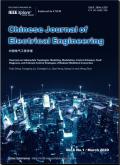Research and Modeling on the Characteristic Changes of EMI Filter Passive Components under the Influence of Aging
Q1 Engineering
引用次数: 1
Abstract
At present, the power density of power electronic devices in data centers and electric vehicles is constantly increasing, and numerous electronic components are concentrated in a tight, high-temperature environment, which aggravates the performance degradation of electronic components. Consequently, X and Y capacitors, common-mode inductors, and differential-mode inductors used for electromagnetic interference (EMI) suppression suffer from aging effects, and their performance continues to decline. However, the electromagnetic compatibility test is often conducted immediately after the power electronic equipment leaves the factory. The electromagnetic compatibility of power electronic equipment is affected by aging, which is not assessed in current industrial testing. This study conducts aging experiments on passive electronic components in EMI filters and measures the impedance in the frequency range from 150 kHz to 30 MHz. Subsequently, a multi-element aging model based on electromagnetic field analysis is established. The proposed model is suitable for electromagnetic compatibility analysis considering aging. Finally, the aging performance of a commercial two-stage EMI filter is predicted to verify the model proposed in the study. The proposed model explains the degeneration of the EMI filter with aging in the frequency range of 150 kHz to 1 MHz, with a maximum amplitude error of 0.58 dB and phase error of 1.0°.EMI滤波器无源元件老化影响下特性变化的研究与建模
目前,数据中心和电动汽车中电力电子器件的功率密度不断提高,众多电子元件集中在一个严密、高温的环境中,加剧了电子元件的性能退化。因此,用于抑制电磁干扰(EMI)的X和Y电容器、共模电感和差模电感受到老化效应的影响,其性能持续下降。然而,电磁兼容性测试往往是在电力电子设备出厂后立即进行的。电力电子设备的电磁兼容性会受到老化的影响,目前的工业测试尚未对其进行评估。本研究对EMI滤波器中的无源电子元件进行老化实验,并在150 kHz至30 MHz的频率范围内测量阻抗。在此基础上,建立了基于电磁场分析的多元素老化模型。该模型适用于考虑老化的电磁兼容分析。最后,对商用两级EMI滤波器的老化性能进行了预测,以验证所提出的模型。该模型解释了在150 kHz ~ 1 MHz频率范围内EMI滤波器的老化退化,最大幅度误差为0.58 dB,相位误差为1.0°。
本文章由计算机程序翻译,如有差异,请以英文原文为准。
求助全文
约1分钟内获得全文
求助全文
来源期刊

Chinese Journal of Electrical Engineering
Energy-Energy Engineering and Power Technology
CiteScore
7.80
自引率
0.00%
发文量
621
审稿时长
12 weeks
 求助内容:
求助内容: 应助结果提醒方式:
应助结果提醒方式:


